What is a Cappuccino? Everything You Need to Know!
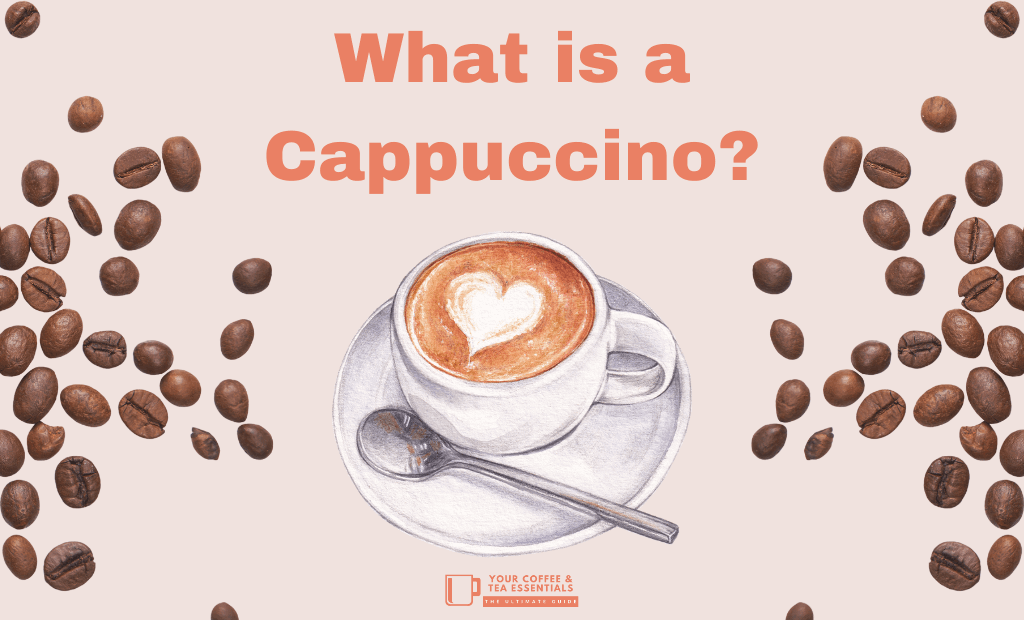
If you've ever wondered "What is a Cappuccino, Anyway?", then you've come to the right place because we love cappuccinos and can't wait to tell you all about them!
Have you ever taken a sip of a warm and frothy cappuccino and wondered about its origins and how it's made?
If you're a coffee lover or simply curious about one of the world's favorite coffee beverages, we have you covered!
Let's dive into the history, ingredients, and preparation methods that make the cappuccino a beloved classic.
The Origin of the Cappuccino
As you may have guessed by the sound of the word, cappuccinos originated in Italy. The word for 2 or more “cappuccinos” is actually Cappuccini in Italian. Cappuccino means just one drink.
I bet you didn't even know that... Well, neither did we, until recently!
Italians are probably shaking their heads at our English pronunciation of their classic coffee drink, so let’s give credit where credit is due.
Like the latte and the flat white, the origin of the cappuccino is clouded in mystery. One legend says this while another says that.
One theory claims that the name originates from the Capuchin Franciscan Friars, a religious order within the Catholic Church. These people wore dark brown garments as part of their spiritual attire, much like the color of a cappuccino (1).
However, these friars added a small portion of dark, brewed coffee to their milk… not exactly the espresso-based cappuccino we know today.
Another legend has it that Italian monk Marco d’Aviano invented the drink after the Battle of Vienna. The Viennese used the term “Kapuziner” for an early version of the cappuccino that included whipped cream and various spices (2).
Whether or not any of these are true, the drink was unknown to the rest of the world outside of Italy until the 1930s.
It’s also possible that the cappuccino was born in the city of Trieste in the northeast of Italy during the Austro-Hungarian Empire in the early 1900s.
From there, people started drinking cappuccinos in coffee houses in other parts of Italy after World War I, and then later worldwide.
Since the 1930s, it’s customary for Italians to consume cappuccinos in the morning as a breakfast drink, usually with a sweet pastry.
What is a Cappuccino, Exactly?
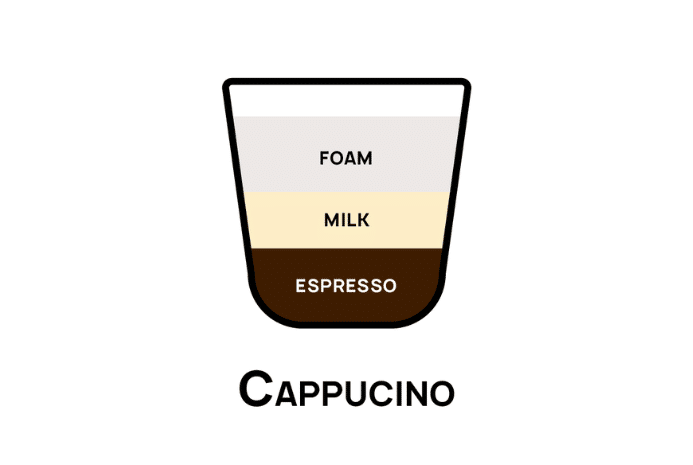
Alright, enough history. You’re probably wondering what is a cappuccino exactly and how it’s different from other espresso coffee drinks.
A cappuccino is an espresso-based coffee beverage made by combining equal parts of espresso, steamed milk, and milk foam. It is typically served in a 5-6 ounce ceramic cup (like porcelain) to help retain heat.
Depending on where you order your cappuccino, it may come with one or two shots of espresso.
To make a cappuccino, a shot of espresso is first extracted and poured into the cup. Then, an equal amount of steamed milk is added, followed by a layer of milk foam on top.
The foam is created by using a steam wand to aerate the milk, which creates a thick, frothy texture.
While the traditional ratio of ingredients calls for ⅓ espresso, ⅓ steamed milk, and ⅓ milk foam, some variations may include more or less milk. If you use a 2-ounce double shot of espresso, expect to use 2 ounces of steamed milk and 2 ounces of milk foam.
However, the exact ratio you use depends on your personal preference. For example, many Americans use more steamed or frothed milk for a milder espresso taste and greater sweetness.
Cappuccinos are often served as a morning or mid-day drink and are popular in coffee shops around the world. They can be enjoyed on their own or paired with a pastry or biscuit.
Variations of the Cappuccino

Of course, what would another coffee drink be without lots of variations?
Cappuccinos are like the fashion models of the coffee world - they come in all shapes and sizes, and each one has its own unique style.
Here are some of the variations that you might see at your favorite coffee shop:
- Dry cappuccino: This variation has more frothed milk than steamed milk, creating a drier texture. It's sometimes called a Cappuccino Scuro (“dark” in Italian) and is popular in Italy. You’re bound to get a milk mustache if you drink a dry cappuccino. You can even get rid of the steamed milk altogether with a bone-dry cappuccino.
- Wet cappuccino: This variation has more steamed milk than frothed milk, creating a wetter texture. It's sometimes called a Cappuccino Chiaro (“light” in Italian) and is popular in the United States. The texture of the milk is more like a latte in this style.
- Flavored cappuccino: This variation adds flavor syrups like vanilla, caramel, or hazelnut to the traditional cappuccino. This type of cappuccino is particularly popular in chain coffee shops like Starbucks. Expect a lot of added sugar if you order a flavored cappuccino.
- Iced cappuccino: This variation is made by pouring a shot of espresso over ice, then adding cold milk and milk froth on top. It's a refreshing summer drink that's sure to refresh you when it’s hot out!
- Chocolate cappuccino: This variation adds chocolate to the traditional cappuccino. This can be in the form of a dusting of cocoa powder or by adding chocolate syrup to the milk. Chocolate cappuccinos are approaching mocha territory, but mochas are usually served with whipped cream.
- Vegan cappuccino: This variation replaces dairy milk with plant-based milk such as almond, soy, or oat milk.
How to Make a Cappuccino
Now that you know all the different types of cappuccinos, let’s focus on making the classic Italian version.
Before making your cappuccino, it’s important to consider the following:
- Ingredients: 8-18 grams of ground coffee, 3-4 ounces of milk
- Equipment needed: espresso machine with steam wand and pitcher
- Grind size: Make sure to grind your coffee “very fine” whenever making espresso. We recommend using a burr grinder for consistent particle sizes, but you can ask your local coffee shop to grind your espresso beans for you, too.
- Coffee roast: Start with medium to dark coffee roasts when making this drink. Try to stick to origins known for having notes of chocolate, nuts, and caramel, or try a blend specifically roasted for espresso.
- Milk: Milk with higher fat content will froth quickly, which is what you want. Whole milk is the most fat-heavy dairy and is highly recommended, while oat milk is a good plant-based alternative.
How to Prepare a Cappuccino with Steamed Milk
Step 1: Pull the espresso shots
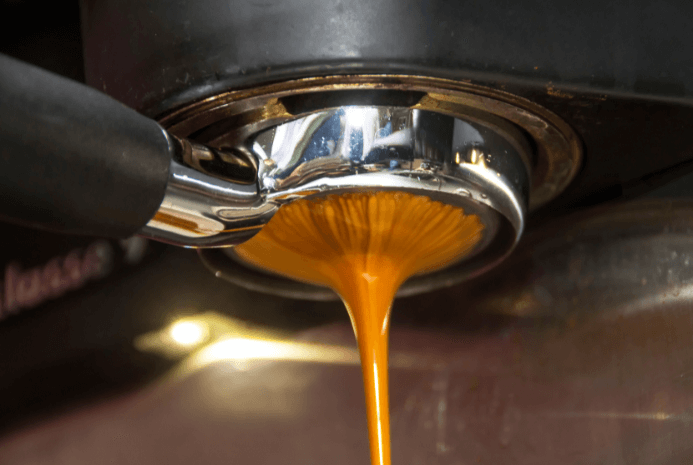
Using an espresso machine, pull a 1-ounce single shot of espresso (8-9 grams of coffee) for a weaker coffee flavor or a 2-ounce shot of double espresso (16-18 grams of coffee) for a stronger coffee flavor. Make these directly into a 5-6 ounce warmed-up ceramic cup.
Step 2: Steam the milk
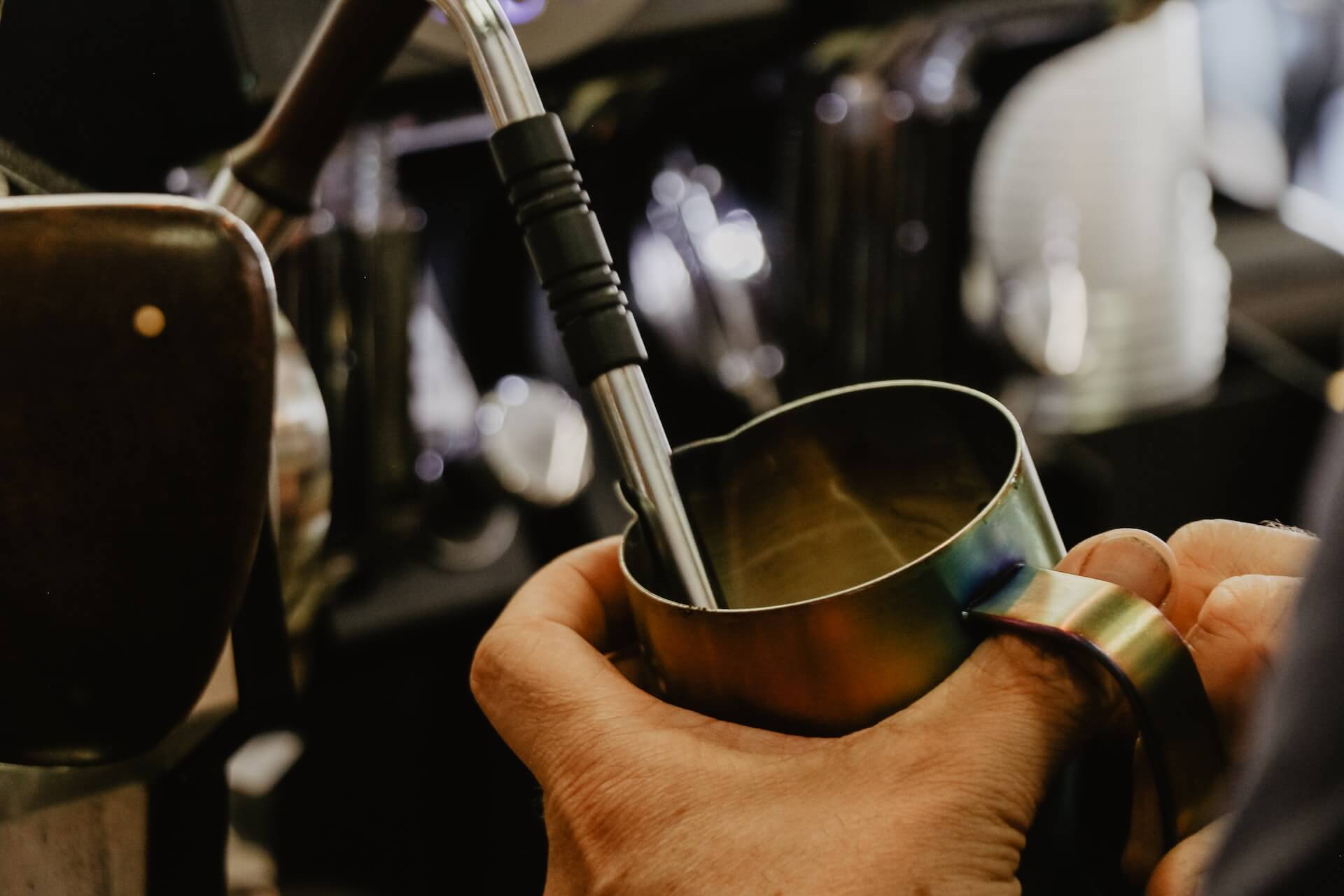
Pour the milk into the pitcher and use the steam wand on your espresso machine to froth the milk. This step works better if both the milk and pitcher are chilled before starting.
Keep the pitcher at an angle to create a vortex in the pitcher, and slowly steam the milk until a thin layer of foam appears on top. Keeping the steam wand deeper in the pitcher until the very end will create a creamier microform.
When the steam wand gets toward the surface of the milk, you will be making the “frothier” milk used as the top layer. The longer you keep the steam wand at the surface of the milk, the more milk foam you will have.
Step 3: Pour the milk into the espresso
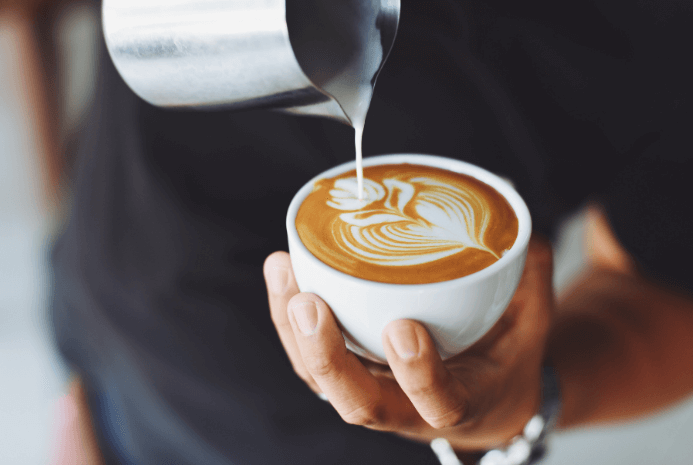
Pour the milk into the cup that already has the espresso shot(s). Hold the pitcher slightly above the glass, bringing it gradually closer to the surface of the drink while pouring in the center.
Perform this step slowly, making sure that the milk flows first with the thicker froth following at the end of the pour. Channel your inner barista and try your hand at some latte art!
How to Make a Cappuccino At Home Without an Espresso Machine
While using an espresso machine is the only way to make the real espresso necessary for a traditional cappuccino, you can get by without one and create something similar.
Since many people don’t have espresso machines in their homes, here’s a recipe for making a modified cappuccino using other coffee maker types such as a French press, Aeropress, or Moka pot.
Step 1: Make the “espresso”
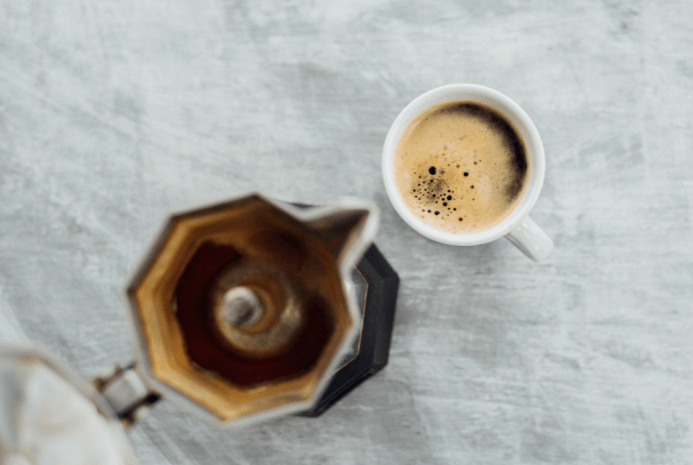
We recommend making a very concentrated 1-2 ounces of coffee to mimic a single or double shot of espresso (depending on how weak or strong you want the coffee flavor to be). You can do this with a French press, Aeropress, or Moka pot. Just make sure to increase the amount of coffee you normally use.
The most traditional method for making a cappuccino without an espresso machine is with a Moka pot. Many Italians still make their morning cup using this method. Delizioso!
Step 2: Froth the milk
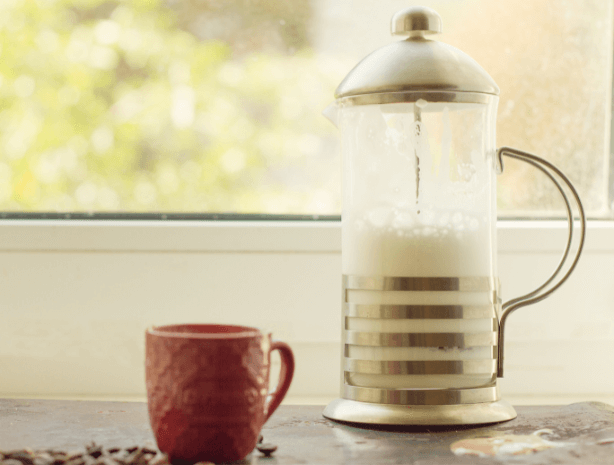
If you have a dedicated milk frother, use that to froth 3-4 ounces of milk into a pitcher. If you don’t have a frother, you can use a French press. Simply fill the device with warm or hot milk and move the plunger up and down until you get a frothy texture. Prepare to finish this coffee-making experience with bigger biceps!
Step 3: Combine coffee and milk
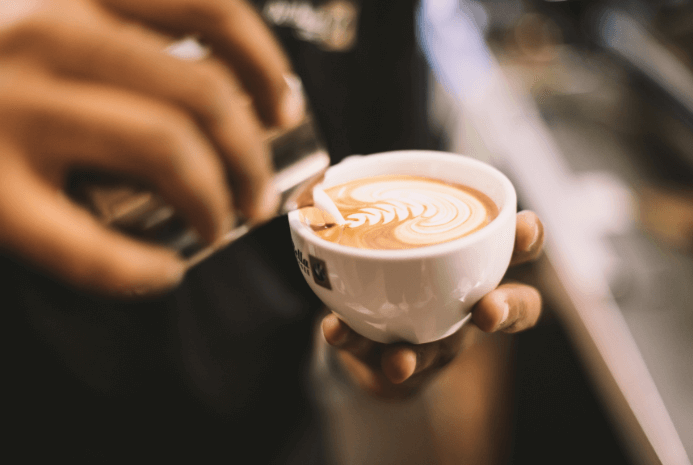
Remove the plunger from the French press and tap it gently on the table to remove any large air bubbles. Just be careful not to break it if it's a glass French press.
Slowly pour the hot milk into the cup with the “espresso” and enjoy!
Cappuccino vs Latte
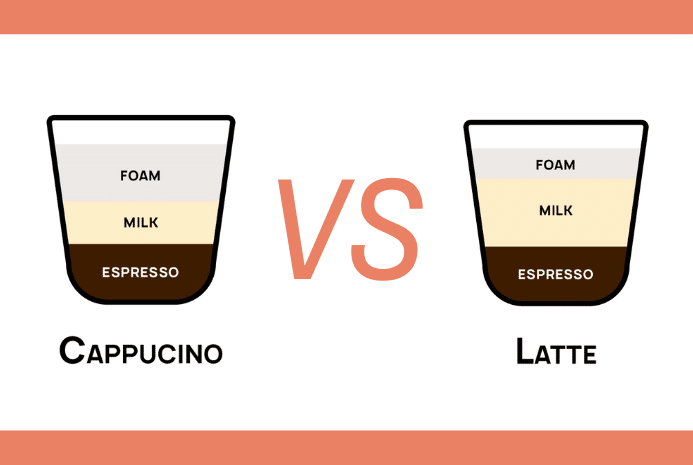
While lattes and cappuccinos are both Italian and can come with one or two shots of espresso, they are very different drinks.
While each uses espresso and steamed milk, everything from texture to size is different.
Lattes come in tall, clear glasses that are 10 ounces or larger. Cappuccinos are served in ceramic mugs that are 5-6 ounces.
The milk in lattes has a richer, creamier texture that lends itself better to latte art (hence the name, latte art). Cappuccinos use milk that is also creamy in texture, but the top layer is frothed more and airer. This helps with the “drier” sensation in cappuccinos that doesn’t exist with lattes.
You can see and feel air bubbles on your tongue when drinking the foam of a cappuccino. With the thin microfoam layer of a latte, you shouldn’t be able to feel the bubbles.
Cappuccino vs Macchiato
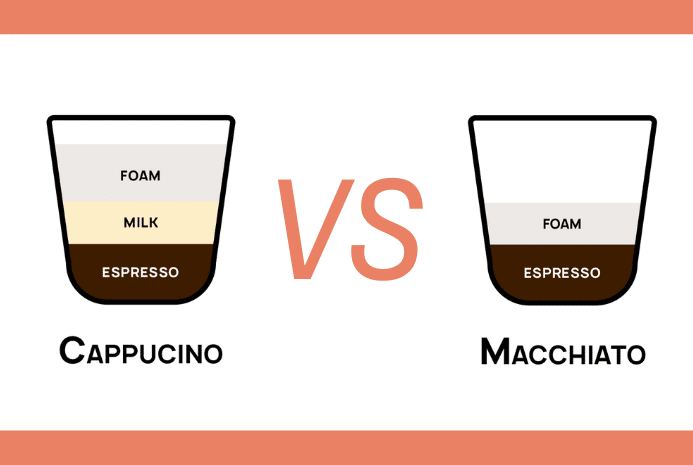
While a cappuccino and a macchiato are both espresso-based coffee beverages, they are prepared and served differently. They also have distinct flavor profiles.
A macchiato is made by adding a small amount of milk foam to a shot of espresso. The term macchiato means "stained" in Italian. In this drink, the espresso shot is "stained" with a small amount of milk.
The milk is added on top of the espresso, without any layering or blending, creating a distinct separation between the espresso and milk. The traditional macchiato is served in a small demitasse cup (a little ceramic coffee cup) and has a bold and strong flavor profile.
Espresso dominates the flavor of a macchiato, while there is a better blending of milk and espresso in a cappuccino due to the balanced ratio.
Similar Popular Posts:
- Cappuccino vs Mocha: What’s the Main Difference?
- Here’s How to Make 7 Delicious Oat Milk Latte Recipes
- Iced Latte vs Iced Coffee: Know All The Differences
- 5 Easy Steps - How to Make a Latte at Home!
- Poop Coffee - The Most Expensive Coffee in the World: Kopi Luwak Coffee
- What is a Breve? What Makes Breve Coffee Different?
Frequently Asked Questions
What is the difference between a cappuccino vs latte?
While both cappuccinos and lattes use espresso and steamed milk, everything from texture to size is different. Lattes come in tall, clear glasses that are 10 ounces or larger. Cappuccinos are served in ceramic mugs that are 5-6 ounces. The milk in lattes has a richer, creamier texture and microfoam. Cappuccinos use milk that is also creamy in texture, but the top layer is airer and more frothed.
What is stronger: cappuccino or latte?
Both a cappuccino and a latte can be made with one or two shots of espresso. The level of caffeine is the same, but cappuccinos tend to taste stronger. Since there is less milk in a cappuccino than in a latte, the rich taste of espresso is stronger in a cappuccino. There is more milk and foam in a latte, which drowns out the coffee taste and makes for a sweeter drink.
What makes a cappuccino different from coffee?
The main difference between a cappuccino and coffee is the milk. Regular coffee doesn’t include milk unless you add it. It’s simply coffee grounds brewed with hot water. A cappuccino comes with 1-2 shots of espresso coffee and layers of steamed and frothed milk, which are all crucial to the drink.
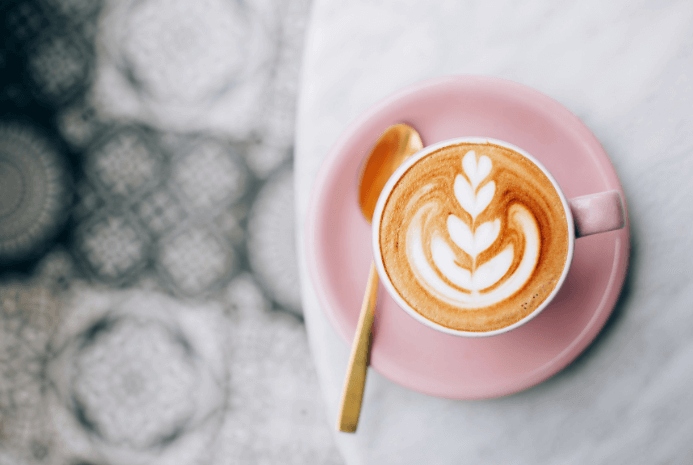
Final Thoughts on What is a Cappuccino!
Alright, that concludes our complete guide to the cappuccino. Now you know the drink’s history and how to make one at home.
This classic Italian coffee beverage has become a popular choice for coffee lovers around the world. Its perfect balance of espresso, steamed milk, and foamed milk creates a delicious and satisfying drink that can be enjoyed any time of day.
So, what are you waiting for? We said any time of day.
Right now is the perfect time to enjoy a classic cappuccino or one of its many variations. Go grab yourself a cup!
This article is intended for informational purposes only. It is not meant to replace professional medical advice, treatment or diagnosis. Do not consume any type of coffee, tea or herbal infusion if you are allergic to it. The information in this article is not intended to treat serious medical conditions. Please seek professional medical advice before using home remedies.